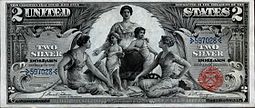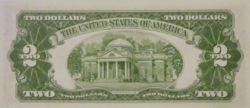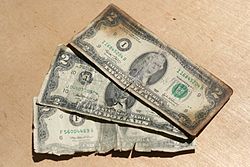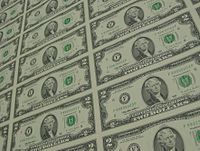- United States two-dollar bill
-
Two dollars (United States) Value: $2 Width: 156 mm Height: 66 mm Security Features: None Paper Type: 75% cotton
25% linenYears of Printing: 1976 – present (Federal Reserve Note) Obverse 
Design: Thomas Jefferson Designer: Design Date: 1928 Reverse 
Design: Trumbull's Declaration of Independence Designer: Design Date: 1976 The United States two-dollar bill ($2) is a current denomination of US currency. President Thomas Jefferson is featured on the obverse of the note. The reverse features an engraved modified reproduction of the painting The Declaration of Independence by John Trumbull.
The bill was discontinued in 1966, but was reintroduced 10 years later as part of the United States Bicentennial celebrations. Today, it is rarely seen in circulation, and as a result the production of the note is the lowest of U.S. paper money: under 1% of all notes currently produced are $2 bills. This comparative scarcity in circulation, coupled with a lack of public awareness that the bill is still in circulation, has also inspired urban legends and, on a few occasions, created problems for people trying to use the bill to make purchases.
Throughout the $2 bill's pre-1929 life as a large-sized note, it was issued as a United States Note, National Bank Note, Silver Certificate, and Treasury or "Coin" Note. When U.S. currency was changed to its current size, the $2 bill was issued only as a United States Note. After United States Notes were discontinued, the $2 bill later began to be issued as a Federal Reserve Note.
Contents
Denomination overview
The denomination of two dollars was authorized under a congressional act and first used in March, 1862.[1] The denomination was continuously used until 1966 when the only class of U.S. currency it was then assigned to, United States Notes, began to be discontinued.[2] The $2 bill initially was not reassigned to the Federal Reserve Note class of United States currency and was thus discontinued; the Treasury Department cited the $2 bill's low use and unpopularity as the reason for not resuming use of the denomination. In 1976 use of the two-dollar denomination was resumed as part of the United States bicentennial and the two-dollar bill was finally assigned as a Federal Reserve Note, with a new design on the back featuring John Trumbull's depiction of the drafting of the United States Declaration of Independence replacing the previous design of Monticello. It has remained a current denomination since then.[3] Today, two-dollar bills are not frequently reissued in a new series like other denominations which are printed according to demand; two-dollar bills today are issued but are requested to be printed less often than the other denominations.[4]
Though some cash registers accommodate it, its slot is often used for things like checks and rolls of coins. Some vending machines accommodate it,[5] and self-checkout lanes have been known to do so, even if the fact is not stated on the label. Although they usually are not handed out arbitrarily, two-dollar bills can often be found at banks by request.
Rarity
The rarity of a $2 bill can be attributed to its low printing numbers that sharply dropped beginning in the late 1950s when the $2 bill was a United States Note and recently the sporadic printings of still relatively low numbers as a Federal Reserve Note. Lack of public knowledge of the $2 bill further contributes to its rarity. This rarity can lead to a greater tendency to hoard any $2 bills encountered and thus decrease their circulation.
Supplies of the Series 1976 $2 bill were allowed to dwindle until August 1996 when another series finally began to be printed; this series, however, was only printed for the Federal Reserve Bank of Atlanta. Once again, in October 2003, the $2 bill was printed for only the Federal Reserve Bank of Minneapolis after supplies dwindled. Because of an increase in demand for supplies of the note, in 2006 Series 2003A bills were issued for all Federal Reserve Banks.[6]
Until the late 1980s, $2 bills were quite common in Europe with military personnel. The money circulating outside the USA could not easily be taken out of circulation, so bills stayed in use much longer than intended, sometimes in very bad shape, even with pieces taped together.
Today, there is a common misconception by the public that the $2 bill is no longer in circulation. According to the Treasury, they "receive many letters asking why the $2 bill is no longer in circulation".[7] In response, the Treasury states: "The $2 bill remains one of our circulating currency denominations. According to B.E.P. statistics, 590,720,000 Series 1976 $2 bills were printed and as of February 28, 1999, $1,166,091,458 worth of $2 bills were in circulation worldwide." However, "in circulation" does not necessarily mean that the notes are actively circulated, only that this is the amount that has not been redeemed for shredding. The Treasury states that the best way for the $2 bill to circulate is if businesses use them as they would any other denomination.
The most significant evidence of the $2 bill's reawakening would be that, in 2005 alone, 61 million $2 bills were printed by the U.S. Bureau of Engraving and Printing. This is more than twice the number of $2 bills that were printed annually between 1990 and 2001. Many banks stocking $2 bills will not use them except upon specific request by the customer, and even then, may cause a delay with a trip to the vault.[8] Another misconception is that the $2 bill is worth more than its face value; special $2 bills have been made in recent years, however they are not worth anything more than face value on the collectors' market[9] while most current $2 bills are not worth much more than their face value.[10]
History
Large size notes
(approximately 7.4218 × 3.125 in ≅ 189 × 79 mm)
In March 1862, the first $2 bill was issued as a Legal Tender Note (United States Note) with a portrait of Alexander Hamilton; the portrait of Hamilton used was a profile view and is unlike the portrait used currently for the $10 bill.
By 1869 the $2 United States Note was redesigned with the now familiar portrait of Thomas Jefferson to the left and a vignette of the United States Capitol in the center of the obverse. This note also featured green tinting on the top and left side of the obverse. Although this note is technically a United States Note, TREASURY NOTE appeared on it instead of UNITED STATES NOTE. The reverse was completely redesigned. This series was again revised in 1874, changes on the obverse included removing the green tinting, adding a red floral design around WASHINGTON D.C., and changing the term TREASURY NOTE to UNITED STATES NOTE. The 1874 design was also issued as Series of 1875 and 1878 and by 1880 the red floral design around WASHINGTON D.C. on the United States Note was removed and the serial numbers were changed to blue. This note with the red floral design was also issued as Series of 1917 but with red serial numbers by that time.[11]
National Bank Notes were issued in 1875 and feature a woman unfurling a flag and a big 2 (Lazy Duce) on the obverse, the reverse has the king of England smoking tobacco and an eagle with a shield.[12]
In 1886, the first $2 Silver Certificate with a portrait of United States Civil War General Winfield Scott Hancock on the left of the obverse was issued. This design went on until 1891 when a new $2 Silver Certificate was issued with a portrait of U.S. Treasury Secretary William Windom in the center of the obverse.[13]
Two-dollar Treasury or "Coin Notes" were first issued for government purchases of silver bullion in 1890 from the silver mining industry. The reverse featured large wording of TWO in the center and a numeral 2 to the right surrounded by an ornate design that occupied almost the entire note. In 1891 the reverse of the Series of 1890 Treasury Note was redesigned because the treasury felt that it was too "busy" which would make it too easy to counterfeit. More open space was incorporated into the new design.[14]
In 1896 The famous "Educational Series" Silver Certificate was issued. The entire obverse of the note was covered in artwork with an allegorical figure of science presenting steam and electricity to commerce and manufacture. The reverse of the note featured portraits of Robert Fulton and Samuel F. B. Morse surrounded by an ornate design that occupied almost the entire note. By 1899 however, The $2 Silver Certificate was redesigned with a small portrait of George Washington surrounded by allegorical figures representing agriculture and mechanics.[15]
The only large-sized, Federal Reserve Note–like $2 bill was issued in 1918 as a Federal Reserve Bank Note. Each note was an obligation of the issuing Federal Reserve Bank and could only be redeemed at the corresponding bank. The obverse of the note featured a border-less portrait of Thomas Jefferson to left and wording in the entire center. The reverse featured a World War I battleship.[16]
Small size notes
1929 - 1966
(6.14 × 2.61 in ≅ 156 × 66 mm)
In 1929, when all U.S. currency was changed to its current size, the $2 bill was kept only as a United States Note. The obverse featured a cropped version of Thomas Jefferson's portrait that had been on previous $2 bills. The reverse featured Jefferson's home, the Monticello. The note's seal and serial numbers were red. The Series of 1928 $2 bill featured the treasury seal superimposed by the United States Note obligation to the left and a large gray TWO to the right.[17]
In 1953 the $2 bill received design changes analogous to the $5 United States Note. The treasury seal was made smaller and moved to the right side of the bill; it was superimposed over the gray word TWO. The United States Note obligation now became superimposed over a gray numeral 2. The reverse remained unchanged.[18]
The final change to $2 United States Notes came in 1963 when the motto IN GOD WE TRUST was added to the reverse over the Monticello.[19] And, because dollar bills were soon to no longer be redeemable in silver, WILL PAY TO THE BEARER ON DEMAND was removed from the obverse. These $2 bills were officially discontinued in August 1966.
1976 - Present
(6.14 × 2.61 in ≅ 156 × 66 mm)
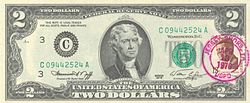 Bicentennial first day of issue $2 bill with canceled JFK postage stamp
Bicentennial first day of issue $2 bill with canceled JFK postage stamp
In 1976, the Treasury Department reintroduced the $2 bill as a cost-saving measure.[20] As part of the United States Bicentennial celebration, the note was redesigned and issued as a Federal Reserve Note. The obverse featured the same portrait of Jefferson, a green instead of red seal and serial numbers, and an engraved rendition of John Trumbull's The Declaration of Independence on the reverse. First day issues of the new bicentennial $2 bills could be taken to a post office and stamped with the date "APR 13 1976". In all, 590,720,000 notes from Series 1976 were printed.
In 1996 and 1997, 153,600,000 bills were printed[21] as Series 1995 for the Federal Reserve District of Atlanta. In 2004, 121,600,000 of the Series 2003 bills were printed for the Minneapolis Federal Reserve Bank. Both of these issues have the same design as the Series 1976 $2 bill. An issue of Series 2003A $2 bills was printed from July to September 2006 for all 12 Federal Reserve Banks. In all, 220,800,000 notes were printed.[6]
Increasing usage
Currency tracking
Over 2.1 million $2 bills are entered at the American currency tracking website Where's George?.[22] A certain niche of site users have made the $2 bill their preferred denomination, and use it frequently.
Use to show economic impact
Because $2 bills are uncommon in daily use, their use can make a particular group of spenders visible. A documented case of using two-dollar bills to send a message to a community is the case of Geneva Steel and the communities in surrounding Utah County. In 1989, Geneva Steel paid its employee bonuses in $2 bills. When the bills began showing up everywhere, people recognized the importance of the company to the local economy.[23] It has been a Clemson University Tigers football tradition dating from September 24, 1977, for the school's fans to spend two-dollar bills on away-game trips. To show the Atlanta business community how much money Clemson fans contributed to the local economy, Tiger fans spent vast quantities of two-dollar bills.[24]
Use as commentary
At least one example exists of a $2 note being used as commentary on economic events. Following the collapse of Bear Stearns, one famous photo surfaced of a two-dollar note taped above the corporate logo at the bank's headquarters in New York, in reference to the per-share price offered as a takeover bid by JPMorgan (down from $93 a share just a month before).[25]
Use as change where tipping is encouraged
$2 notes have seen increased usage in situations where tipping is encouraged, especially in strip clubs. This is due to the idea that tips will increase because of the ease of use of a single, higher-denomination bill as the lowest common note in use. [26]
Legal tender confusion
Since the $2 bill makes up such a small percentage of paper money in circulation, the public sometimes mistakes $2 bills for being counterfeit when used in financial transactions. There have been cases[27][28] where arrests have been made with the Secret Service later stepping in stating that the bills are in fact legal tender.[29]
Uncut currency sheets
Uncut currency sheets are available from the Bureau of Engraving and Printing. Some of the recent $2 uncut sheets from Series 1995 and Series 2003 have indeed been collectibles as they come from special non-circulation printings. Most of the Series 1995 $2 uncut sheets had a higher suffix letter in the serial number than regular circulation $2 bills. Uncut $2 sheets from Series 2003 were printed for the Boston (A), Atlanta (F), Chicago (G), Minneapolis (I), and Dallas (K) Federal Reserve Districts despite the fact that notes from the Minneapolis district were the only ones released for circulation. Uncut sheets of Series 2003A have also been produced, although in this case circulating currency for all districts has also been made. All two dollar bills from Series 1995, 2003, and 2003A have been printed in the BEP facility in Fort Worth, Texas.[6][30][31]
Uncut sheets of $2 bills are available in various sizes. A 32-subject sheet, which is the original size sheet that the notes are printed on, is available. Other sheet sizes available have been cut from the original 32-subject sheet. These include half (16-note), quarter (8-note), and eighth (4-note) sheets for $2 bills. Uncut sheets are sold for more than their respective face values.
References
- ^ "Legal Tender Alexander Hamilton: 1862 $2.00 Currency". The Kennedy Mint. http://kennedymint.net/large_size_currency/large_size_currency.asp?cat2=%242.00+Currencies&cat3=Legal+Tender+Alexander+Hamilton&cat4=1862+%242.00+Currency. Retrieved 2011-02-09.
- ^ "Six Kinds of United States Paper Currency". friesian.com. http://www.friesian.com/notes.htm. Retrieved 2011-02-09.
- ^ "About Paper Money - Small-size Bicentennial $2 notes". Coinworld.com. http://www.coinworld.com/newcollector/PaperMoney/About/Small_Bicentennial.aspx. Retrieved 2011-02-09.
- ^ "$2.00 still printed?". Ustreas.gov. http://www.ustreas.gov/education/faq/currency/denominations.shtml#q3. Retrieved 2010-07-27.[dead link]
- ^ "$2 accepting vending machines". 4mega-vending.com. http://www.4mega-vending.com/dollarbillchanger.htm#AC1001. Retrieved 2011-02-09.
- ^ a b c "Series 2003A $2". USpapermoney.info. http://www.uspapermoney.info/serials/f2003ab.html. Retrieved 2011-02-09.
- ^ "FAQs: Denominations of currency". United States Department of the Treasury. Archived from the original on 2008-06-13. http://web.archive.org/web/20080613130008/http://www.ustreas.gov/education/faq/currency/denominations.shtml. Retrieved 2011-02-09.
- ^ "Use The $2". http://www.usethetwo.com/index.html. Retrieved 2008-10-30.
- ^ bbbconsumeralert (January 27, 2010). "Sometimes a $2 Bill is Just a $2 Bill". Tucson Citizen.com. http://tucsoncitizen.com/bbbconsumeralert/2010/01/27/sometimes-a-2-bill-is-just-a-2-bill/. Retrieved 2011-02-09.
- ^ "Quick Reference Guide to U.S. Paper Money Values". Heritage Auctions, Inc.. http://currency.ha.com/c/ref/worth.zx. Retrieved 2011-02-09.
- ^ A Guide Book of United States Paper Money. Whitman Publishing, LLC. 2005. pp. 88–90. ISBN 0794817866. http://books.google.com/?id=FjYxIAAACAAJ&dq=0794823629. Retrieved 2011-02-09.
- ^ A Guide Book of United States Paper Money. Whitman Publishing, LLC. 2005. p. 91. ISBN 0794817866. http://books.google.com/?id=FjYxIAAACAAJ&dq=0794823629. Retrieved 2011-02-09.
- ^ A Guide Book of United States Paper Money. Whitman Publishing, LLC. 2005. pp. 91–92. ISBN 0794817866. http://books.google.com/?id=FjYxIAAACAAJ&dq=0794823629. Retrieved 2011-02-09.
- ^ A Guide Book of United States Paper Money. Whitman Publishing, LLC. 2005. pp. 95–96. ISBN 0794817866. http://books.google.com/?id=FjYxIAAACAAJ&dq=0794823629. Retrieved 2011-02-09.
- ^ A Guide Book of United States Paper Money. Whitman Publishing, LLC. 2005. pp. 93–94. ISBN 0794817866. http://books.google.com/?id=FjYxIAAACAAJ&dq=0794823629. Retrieved 2011-02-09.
- ^ A Guide Book of United States Paper Money. Whitman Publishing, LLC. 2005. pp. 96–97. ISBN 0794817866. http://books.google.com/?id=FjYxIAAACAAJ&dq=0794823629. Retrieved 2011-02-09.
- ^ A Guide Book of United States Paper Money. Whitman Publishing, LLC. 2005. p. 97. ISBN 0794817866. http://books.google.com/?id=FjYxIAAACAAJ&dq=0794823629. Retrieved 2011-02-09.
- ^ A Guide Book of United States Paper Money. Whitman Publishing, LLC. 2005. p. 98. ISBN 0794817866. http://books.google.com/?id=FjYxIAAACAAJ&dq=0794823629. Retrieved 2011-02-09.
- ^ A Guide Book of United States Paper Money. Whitman Publishing, LLC. 2005. p. 99. ISBN 0794817866. http://books.google.com/?id=FjYxIAAACAAJ&dq=0794823629. Retrieved 2011-02-09.
- ^ Stone, Suzanne J. (Mar/Apr 1976 Vol. 62 No. 2). "The $2 Bill Returns". http://wcdc42.com/2dollar/economic_reviews.html#cost. Retrieved 2011-02-09.
- ^ Bureau of Engraving and Printing. "Annual Production Figures". Archived from the original on 2007-03-04. http://web.archive.org/web/20070304205957/http://www.moneyfactory.com/section.cfm/2/51. Retrieved 2007-04-14.
- ^ "Bill Statistics by Denomination". George's Top 10. Where's George? LLC. http://www.wheresgeorge.com/wrapper.php?page=denom. Retrieved 2011-02-09.
- ^ Tad Walch, Deseret News (May 17, 2003). "Geneva workers give their $2 worth". CBS Interactive. http://findarticles.com/p/articles/mi_qn4188/is_20030517/ai_n11388095/.
- ^ Liz Carey (December 28, 2007). "Clemson's $2 bill tradition still going strong". Independent Mail. http://www.independentmail.com/news/2007/dec/28/clemsons-2-bill-tradition-still-going-strong/.
- ^ Foley, Stephen (March 18, 2008). "The fall of Bear Stearns". The Independent. http://www.independent.co.uk/news/business/analysis-and-features/the-fall-of-bear-stearns-797206.html. Retrieved 2011-02-09.
- ^ "$2 bill increasing in use and shedding its 'play-money' image". USA Today. November 7, 2006. http://www.usatoday.com/money/2006-11-06-two-dollar_x.htm. Retrieved 2011-02-17.
- ^ Michael Olesker (March 08, 2005). "A tale of customer service, justice and currency as funny as a $2 bill". The Baltimore Sun. http://articles.baltimoresun.com/2005-03-08/news/0503080089_1_bolesta-pole-baltimore-county. Retrieved 2011-02-09.
- ^ "Letters-General Questions Answered". woz.org. http://archive.woz.org/letters/general/78.html. Retrieved 2011-10-10.
- ^ "Things you probably don't know about money". cnbc.com. http://www.cnbc.com/id/41375422/10_Things_You_Probably_Don_t_Know_About_Money?slide=11. Retrieved 2011-07-18.
- ^ "Series 1995 $2". USpapermoney.info. http://www.uspapermoney.info/serials/f1995_b.html. Retrieved 2011-02-09.
- ^ "Series 2003 $2". USpapermoney.info. http://www.uspapermoney.info/serials/f2003_b.html. Retrieved 2011-02-09.
- Standard Catalog of United States Paper Money, 17th edition published by Krause Publications
- A Guide Book of United States Paper Money. Whitman Publishing, LLC. 2005. pp. 432. ISBN 0794817866. http://books.google.com/?id=FjYxIAAACAAJ&dq=0794823629. Retrieved 2011-02-09.
- The Bureau of Engraving and Printing website
- USpapermoney.info
External links
- The U.S. Bureau of Engraving and Printing's website
- USAToday: "$2 bill increasing in use and shedding its 'play-money' image" 2006-11-06.
United States currency and coinage Topics Current coinage Bullion coinage America the Beautiful Silver Bullion Coins · American Buffalo · American Gold Eagle · American Platinum Eagle · American Silver EaglePaper money See also Categories:- Paper money of the United States
- Thomas Jefferson
- United States Declaration of Independence
Wikimedia Foundation. 2010.


